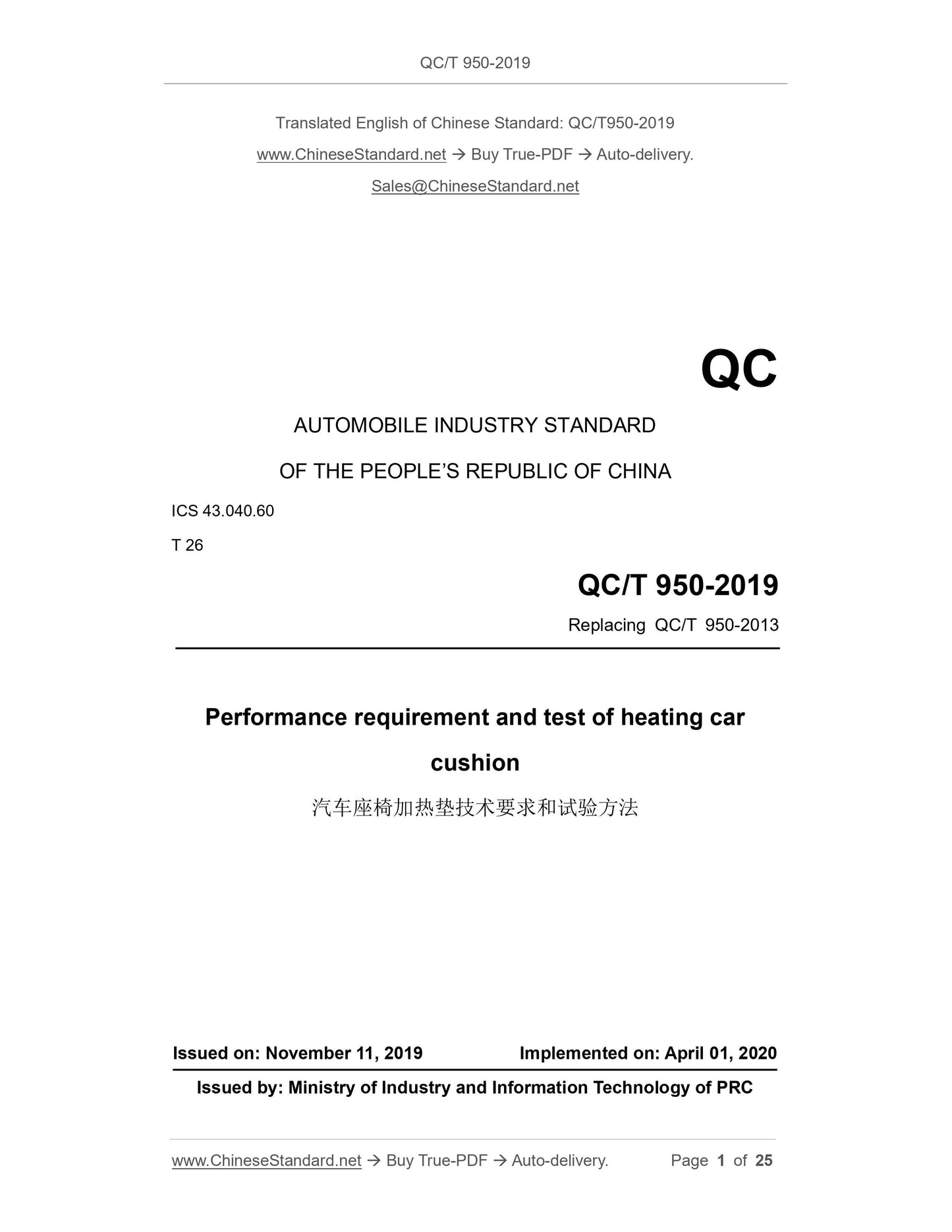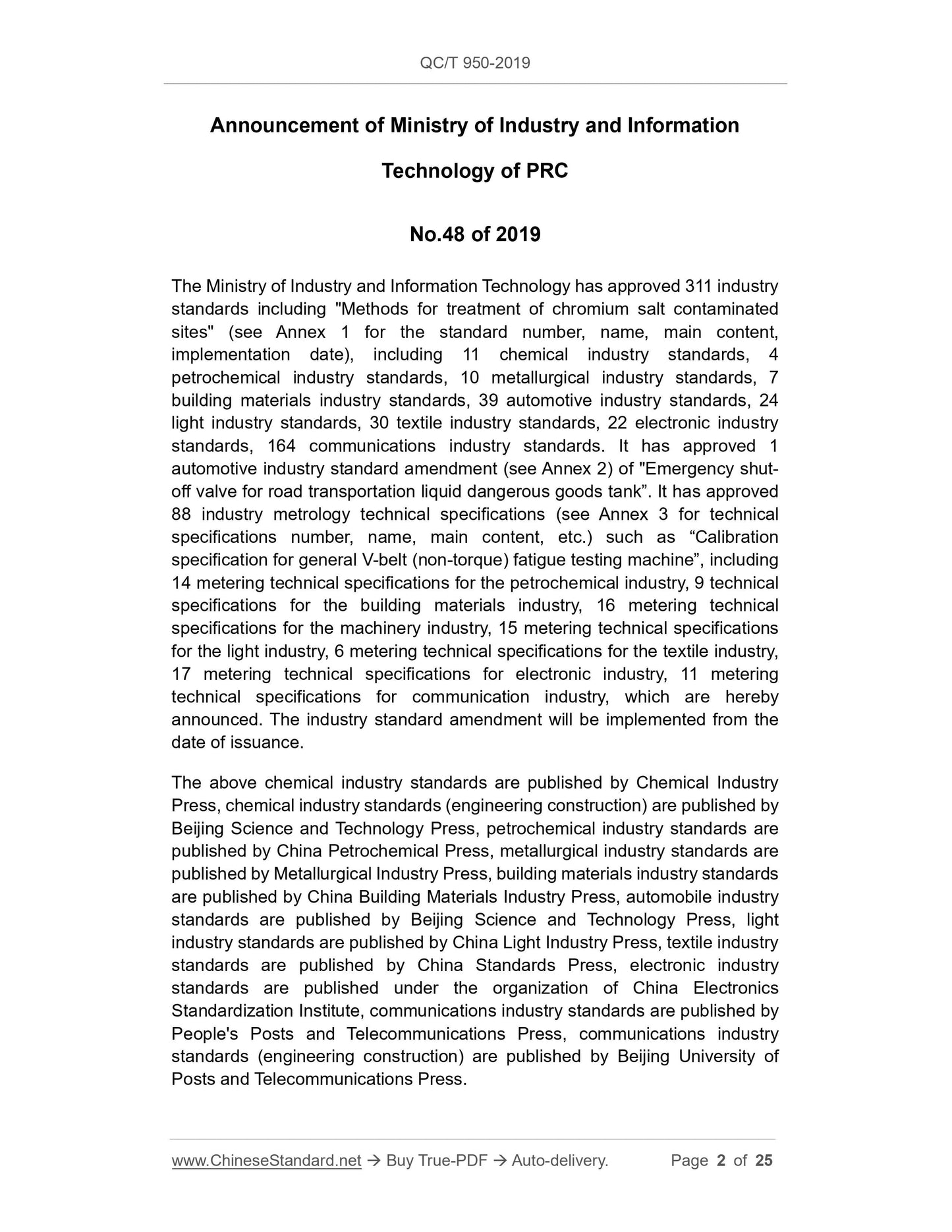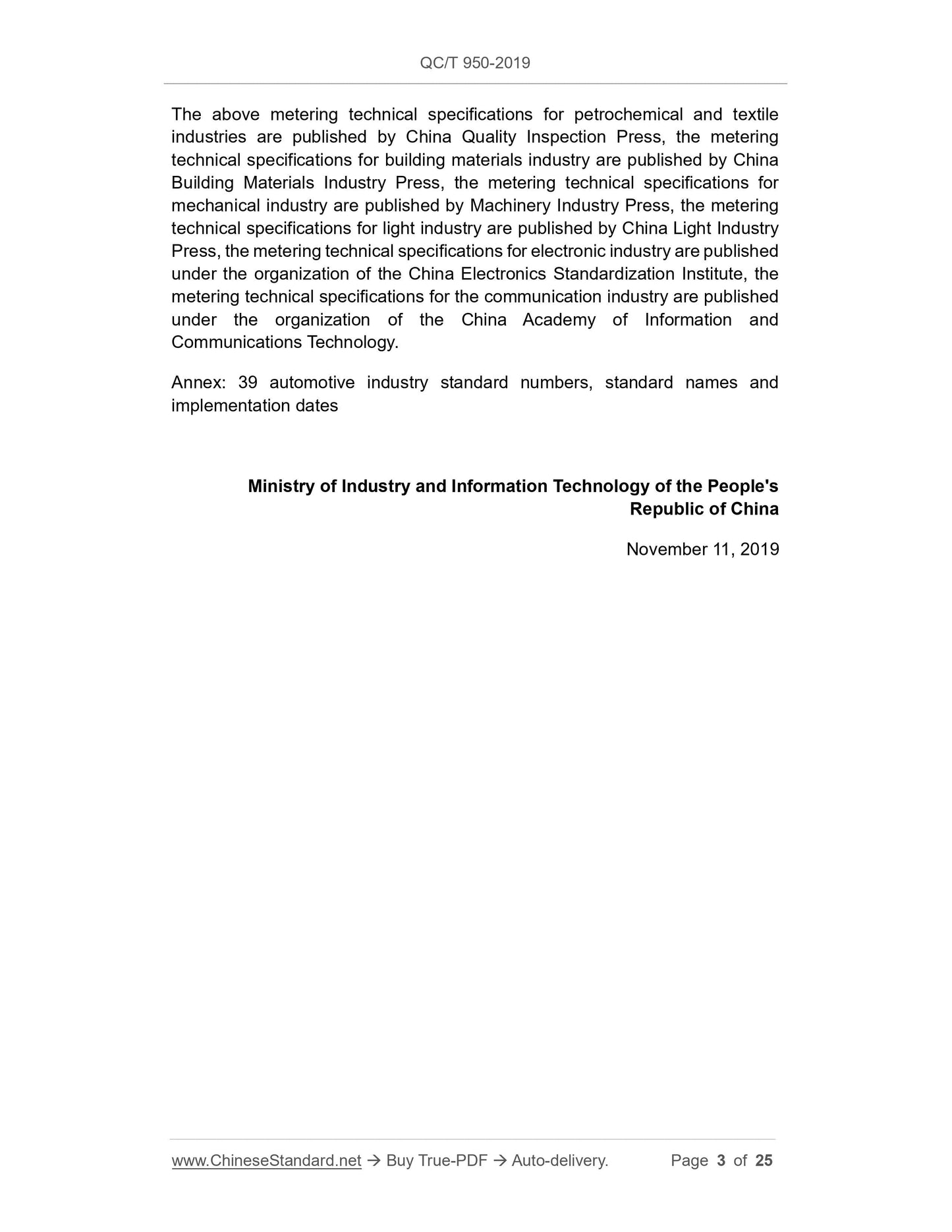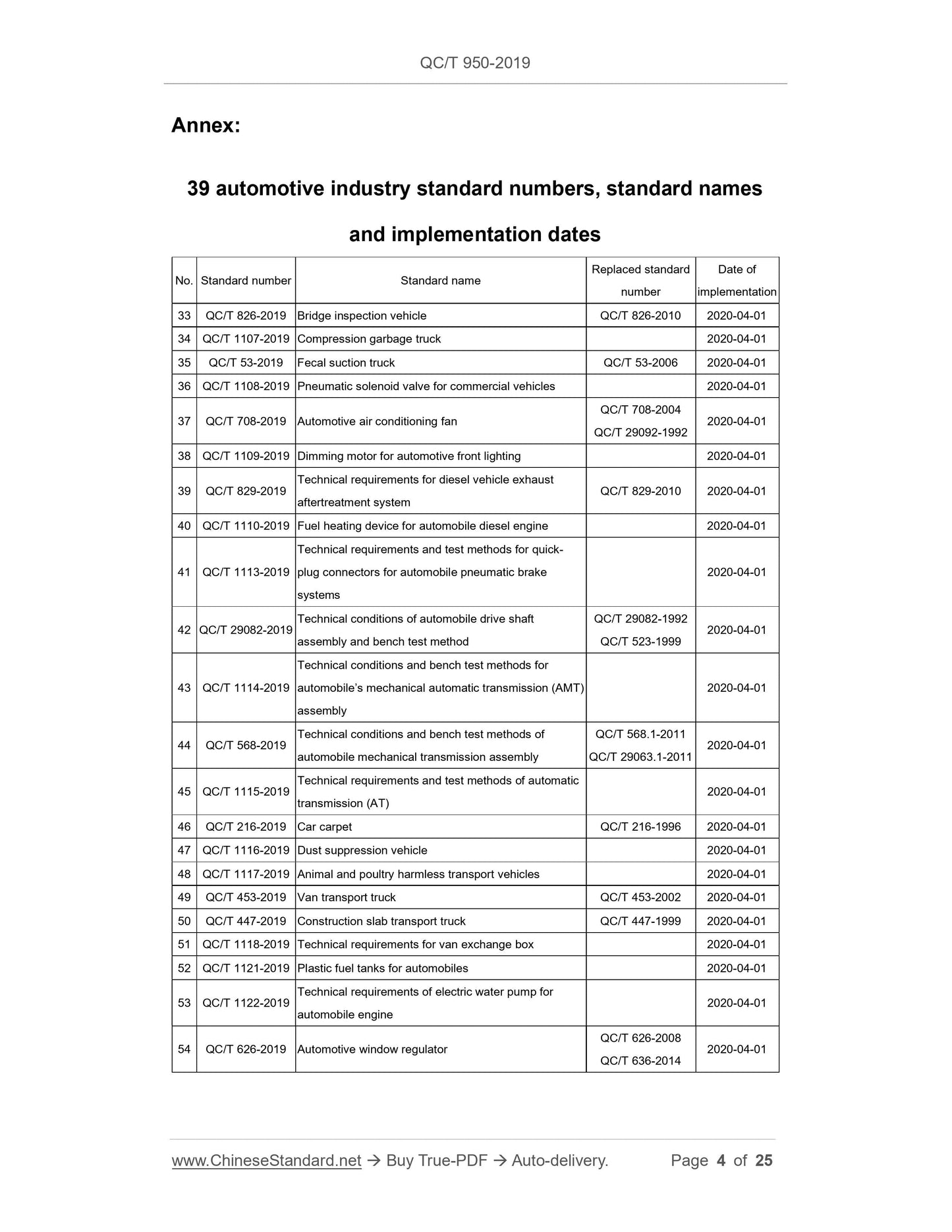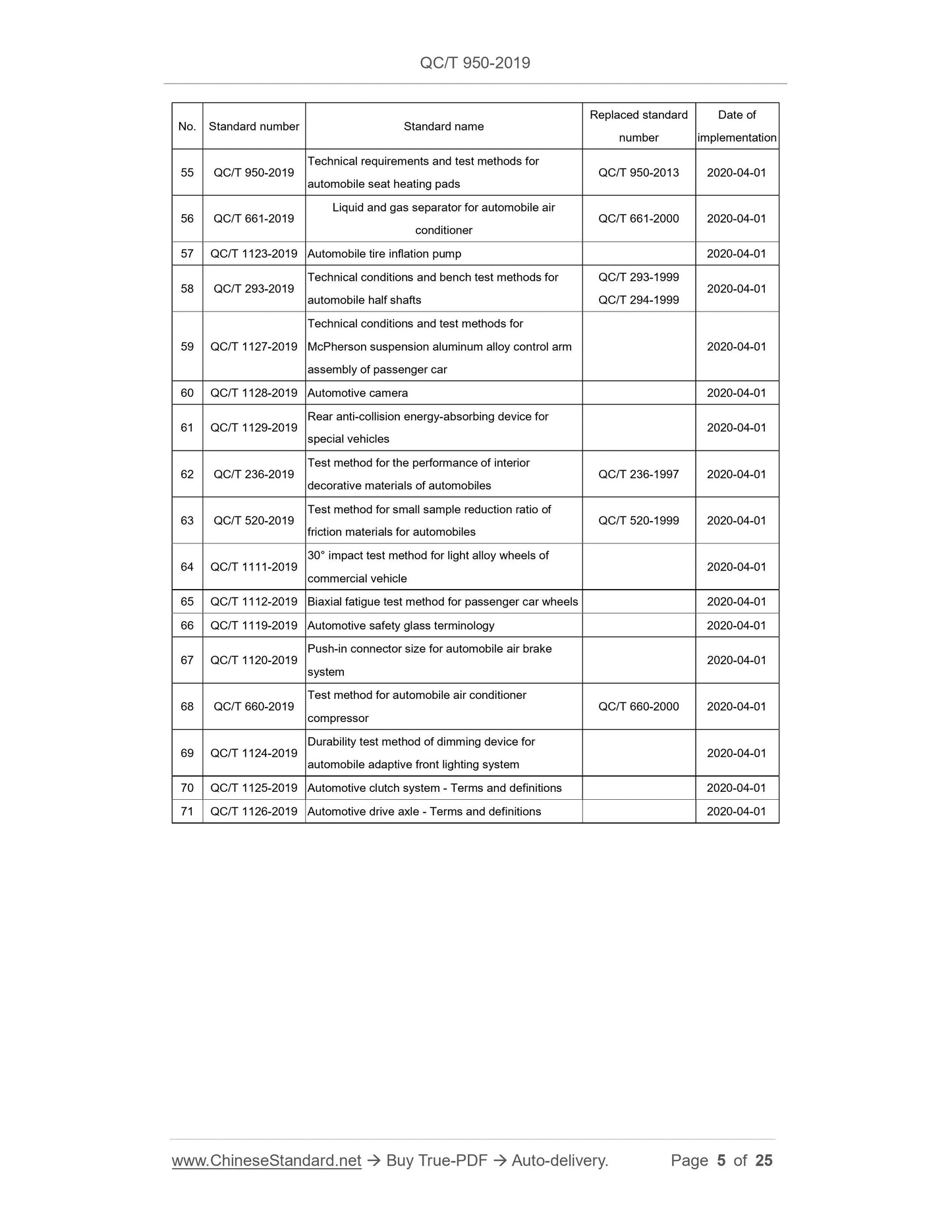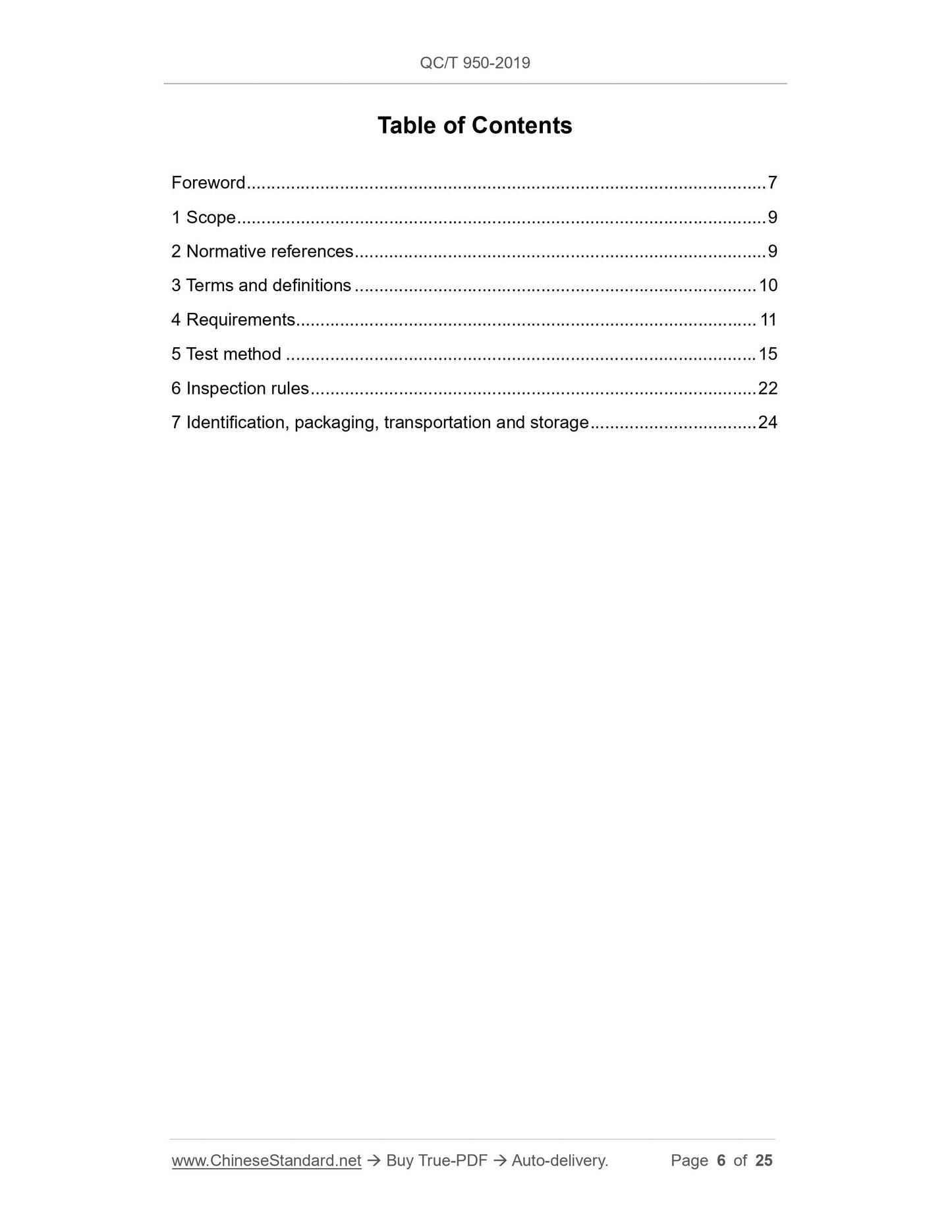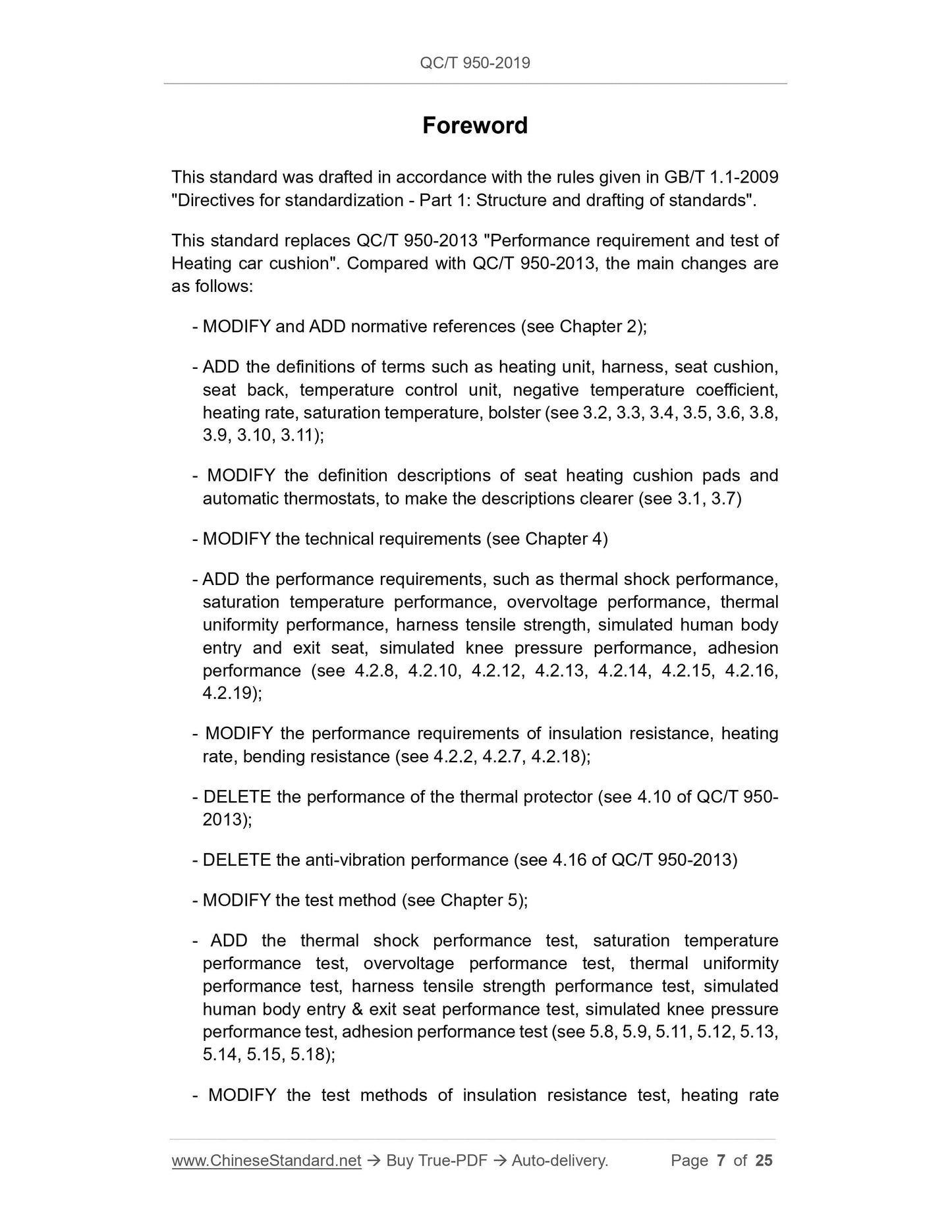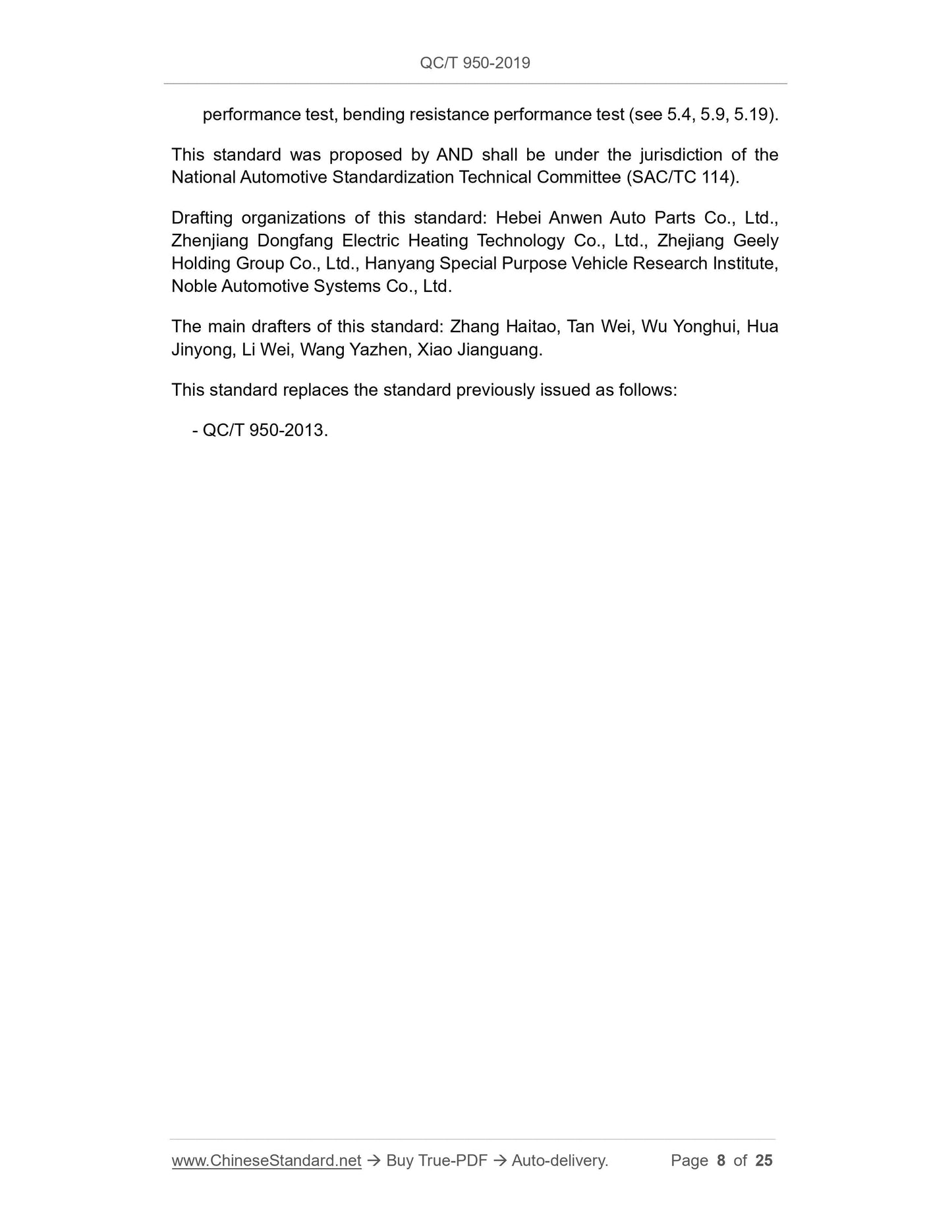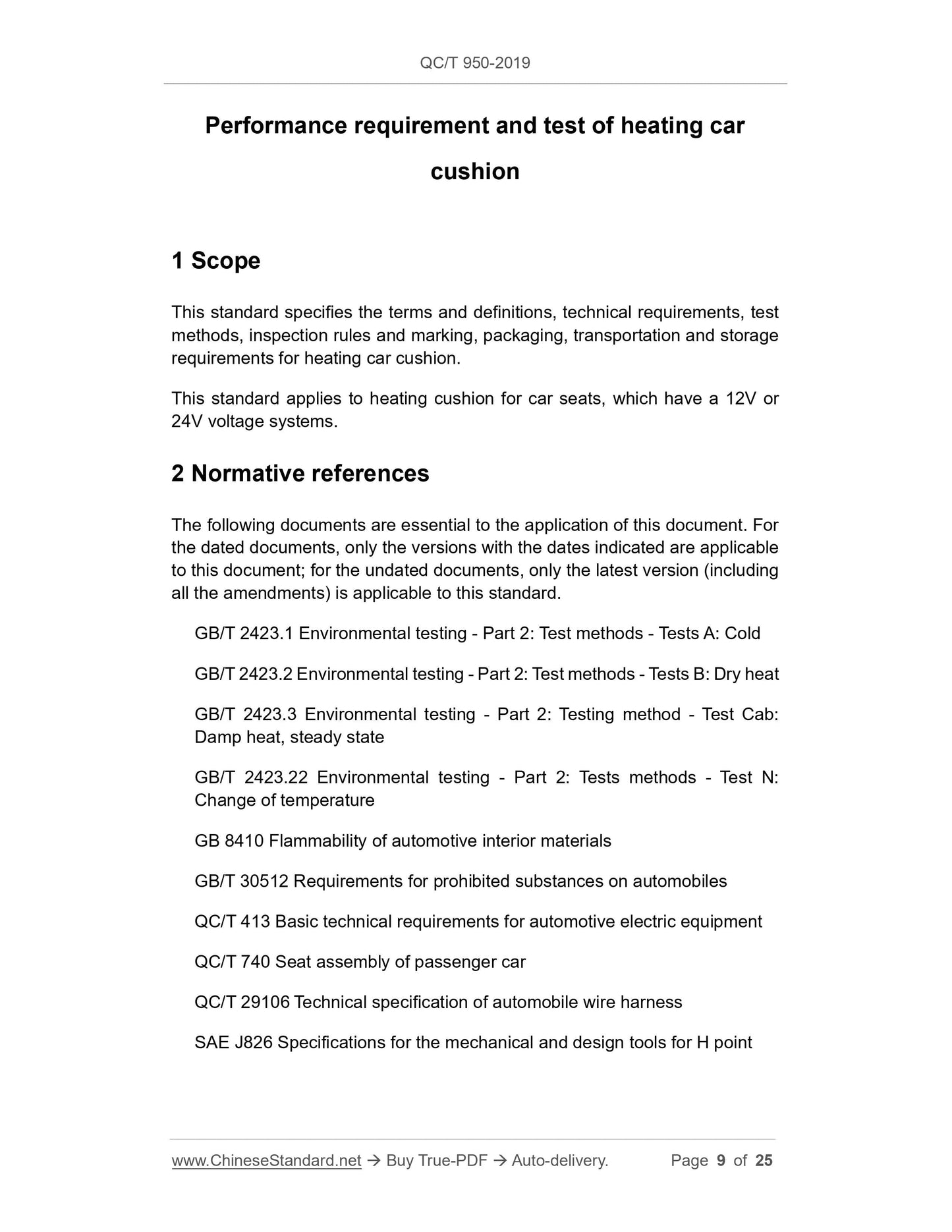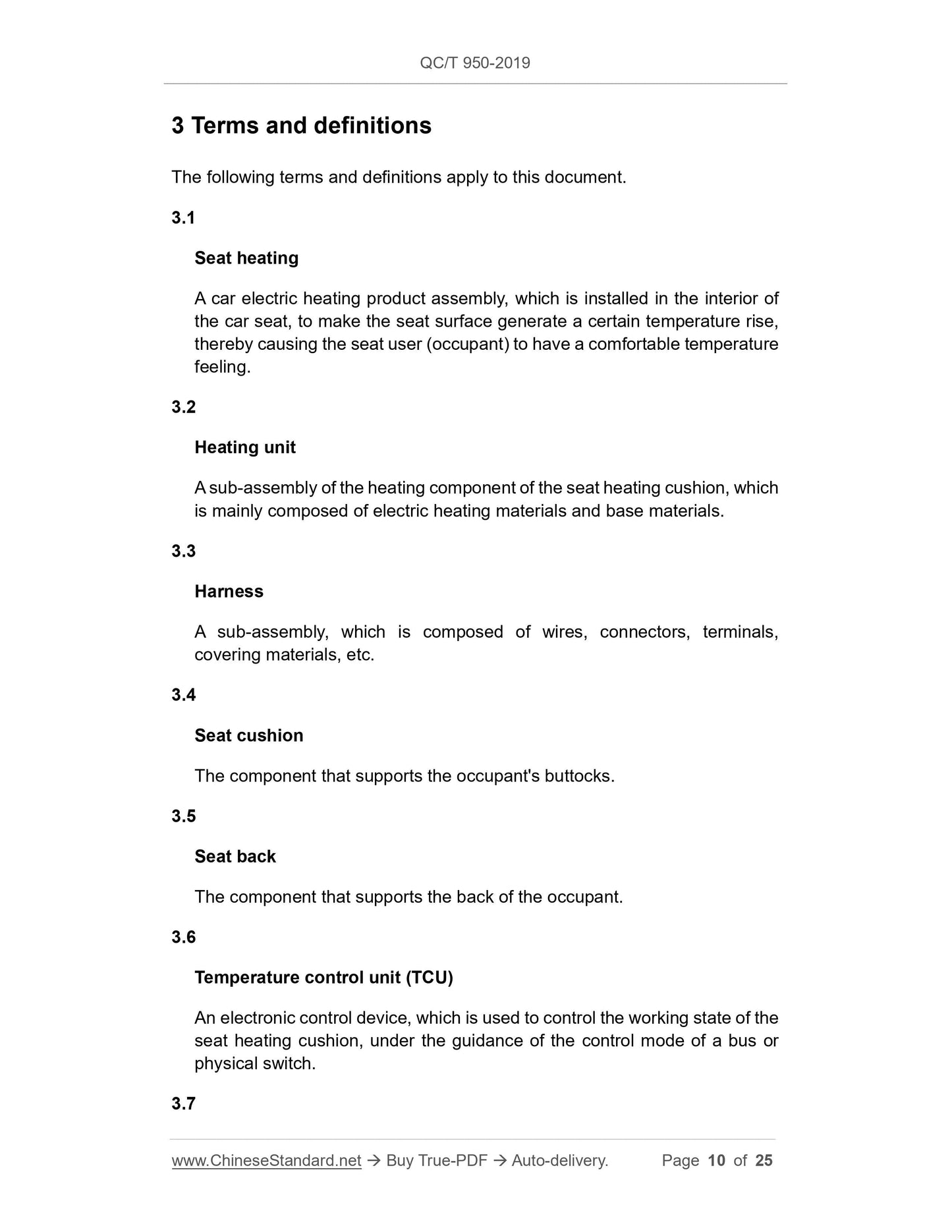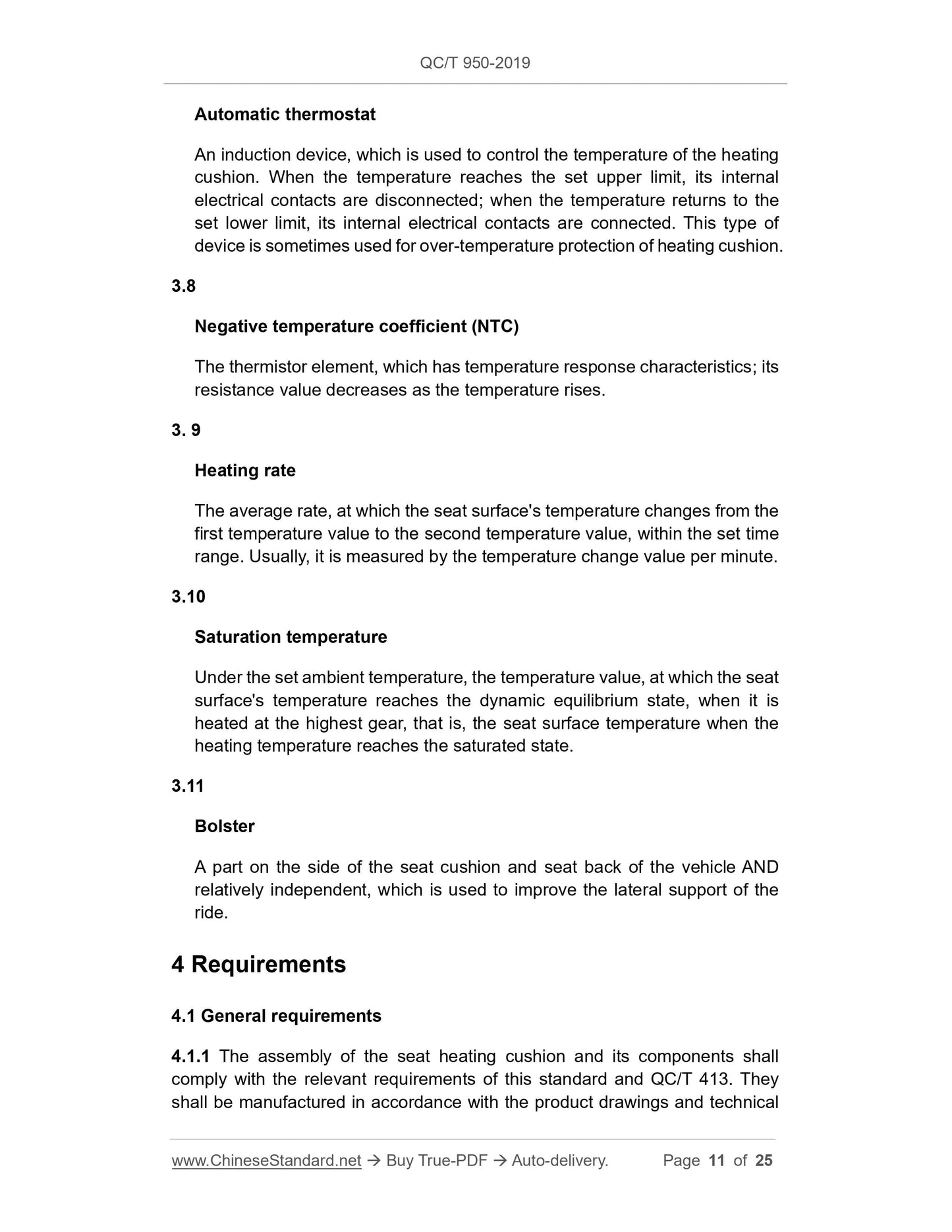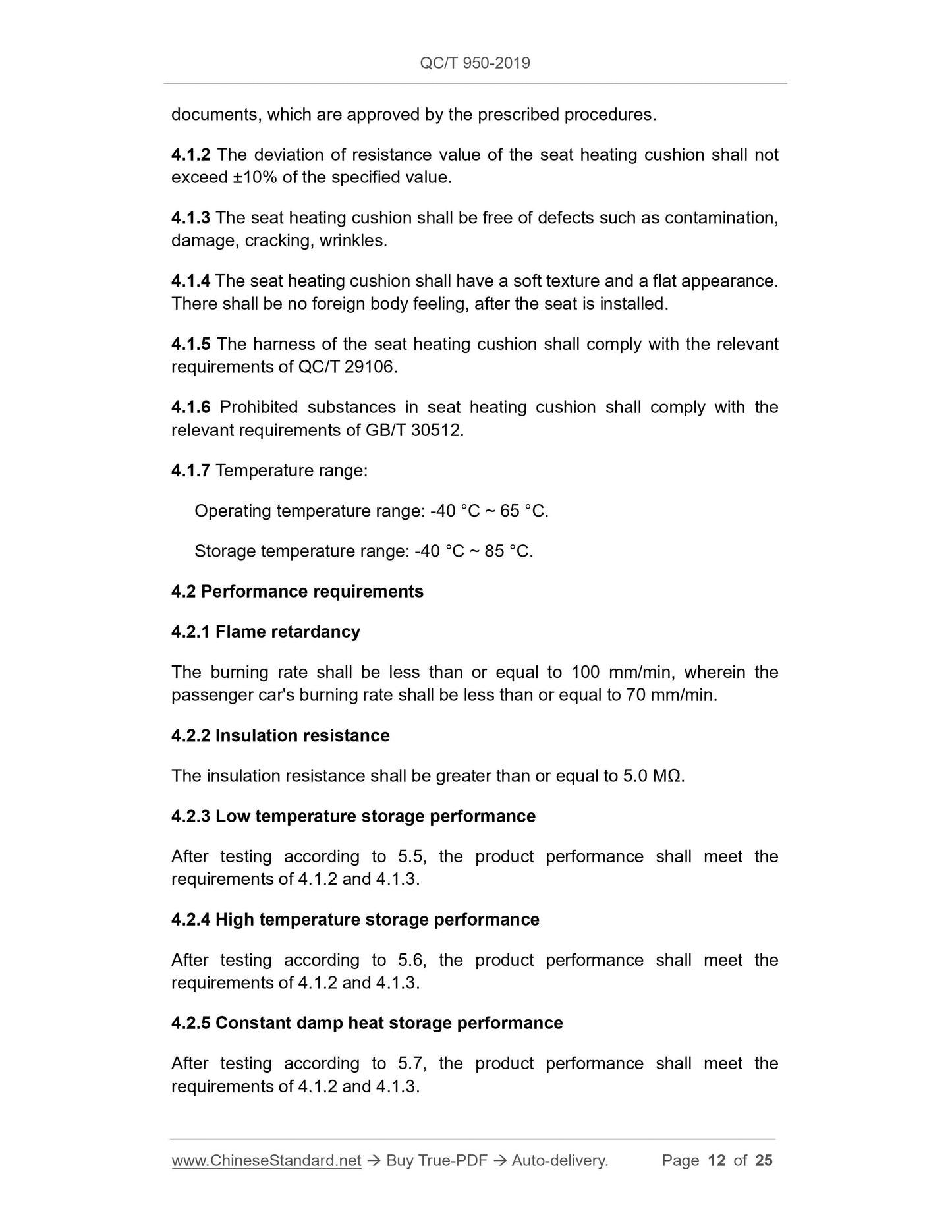1
/
of
12
PayPal, credit cards. Download editable-PDF & invoice in 1 second!
QC/T 950-2019 English PDF (QCT950-2019)
QC/T 950-2019 English PDF (QCT950-2019)
Regular price
$295.00 USD
Regular price
Sale price
$295.00 USD
Unit price
/
per
Shipping calculated at checkout.
Couldn't load pickup availability
Delivery: 3 seconds. Download true-PDF + Invoice.
Get QUOTATION in 1-minute: Click QC/T 950-2019
Historical versions: QC/T 950-2019
Preview True-PDF (Reload/Scroll if blank)
QC/T 950-2019: Performance requirement and test of heating car cushion
QC/T 950-2019
QC
AUTOMOBILE INDUSTRY STANDARD
OF THE PEOPLE’S REPUBLIC OF CHINA
ICS 43.040.60
T 26
Replacing QC/T 950-2013
Performance requirement and test of heating car
cushion
ISSUED ON: NOVEMBER 11, 2019
IMPLEMENTED ON: APRIL 01, 2020
Issued by: Ministry of Industry and Information Technology of PRC
Table of Contents
Foreword ... 7
1 Scope ... 9
2 Normative references ... 9
3 Terms and definitions ... 10
4 Requirements ... 11
5 Test method ... 15
6 Inspection rules ... 22
7 Identification, packaging, transportation and storage ... 24
Performance requirement and test of heating car
cushion
1 Scope
This standard specifies the terms and definitions, technical requirements, test
methods, inspection rules and marking, packaging, transportation and storage
requirements for heating car cushion.
This standard applies to heating cushion for car seats, which have a 12V or
24V voltage systems.
2 Normative references
The following documents are essential to the application of this document. For
the dated documents, only the versions with the dates indicated are applicable
to this document; for the undated documents, only the latest version (including
all the amendments) is applicable to this standard.
GB/T 2423.1 Environmental testing - Part 2: Test methods - Tests A: Cold
GB/T 2423.2 Environmental testing - Part 2: Test methods - Tests B: Dry heat
GB/T 2423.3 Environmental testing - Part 2: Testing method - Test Cab:
Damp heat, steady state
GB/T 2423.22 Environmental testing - Part 2: Tests methods - Test N:
Change of temperature
GB 8410 Flammability of automotive interior materials
GB/T 30512 Requirements for prohibited substances on automobiles
QC/T 413 Basic technical requirements for automotive electric equipment
QC/T 740 Seat assembly of passenger car
QC/T 29106 Technical specification of automobile wire harness
SAE J826 Specifications for the mechanical and design tools for H point
3 Terms and definitions
The following terms and definitions apply to this document.
3.1
Seat heating
A car electric heating product assembly, which is installed in the interior of
the car seat, to make the seat surface generate a certain temperature rise,
thereby causing the seat user (occupant) to have a comfortable temperature
feeling.
3.2
Heating unit
A sub-assembly of the heating component of the seat heating cushion, which
is mainly composed of electric heating materials and base materials.
3.3
Harness
A sub-assembly, which is composed of wires, connectors, terminals,
covering materials, etc.
3.4
Seat cushion
The component that supports the occupant's buttocks.
3.5
Seat back
The component that supports the back of the occupant.
3.6
Temperature control unit (TCU)
An electronic control device, which is used to control the working state of the
seat heating cushion, under the guidance of the control mode of a bus or
physical switch.
3.7
documents, which are approved by the prescribed procedures.
4.1.2 The deviation of resistance value of the seat heating cushion shall not
exceed ±10% of the specified value.
4.1.3 The seat heating cushion shall be free of defects such as contamination,
damage, cracking, wrinkles.
4.1.4 The seat heating cushion shall have a soft texture and a flat appearance.
There shall be no foreign body feeling, after the seat is installed.
4.1.5 The harness of the seat heating cushion shall comply with the relevant
requirements of QC/T 29106.
4.1.6 Prohibited substances in seat heating cushion shall comply with the
relevant requirements of GB/T 30512.
4.1.7 Temperature range:
Operating temperature range: -40 °C ~ 65 °C.
Storage temperature range: -40 °C ~ 85 °C.
4.2 Performance requirements
4.2.1 Flame retardancy
The burning rate shall be less than or equal to 100 mm/min, wherein the
passenger car's burning rate shall be less than or equal to 70 mm/min.
4.2.2 Insulation resistance
The insulation resistance shall be greater than or equal to 5.0 MΩ.
4.2.3 Low temperature storage performance
After testing according to 5.5, the product performance shall meet the
requirements of 4.1.2 and 4.1.3.
4.2.4 High temperature storage performance
After testing according to 5.6, the product performance shall meet the
requirements of 4.1.2 and 4.1.3.
4.2.5 Constant damp heat storage performance
After testing according to 5.7, the product performance shall meet the
requirements of 4.1.2 and 4.1.3.
4.2.6 Thermal shock performance
After testing according to 5.8, the product performance shall meet the
requirements of 4.1.2 and 4.1.3.
4.2.7 Heating rate performance
When the initial ambient temperature is 0 °C, turn on the heating mode to the
highest gear. 5 minutes after the heating starts, the seat surface's temperature
shall not be lower than 30 °C.
4.2.8 Saturation temperature performance
When the initial ambient temperature is 0 °C, turn on the heating mode to the
highest gear. The temperature of the seat surface shall reach the saturation
temperature, within 15 minutes. When the temperature is controlled by the
automatic thermostat, the steady-state temperature of the seat surface, at each
heating mode, shall be within the range of the set temperature ± 5 °C. When
the temperature is controlled by the temperature control unit, the steady-state
temperature of the seat surface, at each heating mode, shall be within the range
of the set temperature ± 2 °C.
4.2.9 Thermal runaway performance
Short-circuit the temperature control unit or automatic thermostat. Let it work
continuously for 2 hours at the rated voltage. The temperature, at any point on
the seat surface, shall not exceed 85 °C. After the test, the seat assembly shall
be free from ablation, burns, or other thermal damage. The seat heating cushion
and surrounding components shall not fail.
4.2.10 Overvoltage performance
After testing according to 5.11, the seat assembly shall show no functional
damage; the seat heating cushion and its surrounding components shall not be
damaged. After returning to normal working conditions, the seat heating
cushion shall function normally.
4.2.11 Thermal uniformity performance
When the heating temperature at each gear reaches a steady state, the
maximum temperature difference, BETWEEN each temperature measurement
point on the seat surface AND the set temperature value, shall not be greater
than 5 °C.
4.2.12 Harness tensile strength performance
The strength at the connection, BETWEEN the forward wire of the harness
4.2.14 Simulated knee pressure performance
After 5000 tests at each test point in 5.15, the seat heating cushion shall be free
from disconnection, short circuit, abnormal heating, leakage, falling off, damage
to the covering layer, or various other failures. The product performance shall
meet the requirements of 4.1.2.
4.2.15 Simulated road bumps and creep performance
After the seat cushion is subject to 100000 tests AND the seat back is subject
to 50000 tests, according to 5.16, the seat heating cushion shall be free from
disconnection, short circuit, abnormal heating, leakage, shedding, damage to
the covering layer, or various other failures. The product performance shall
comply with the requirements of 4.1.2.
4.2.16 Water and liquid resistance
After the test according to 5.17, the product performance shall meet the
requirements of 4...
Get QUOTATION in 1-minute: Click QC/T 950-2019
Historical versions: QC/T 950-2019
Preview True-PDF (Reload/Scroll if blank)
QC/T 950-2019: Performance requirement and test of heating car cushion
QC/T 950-2019
QC
AUTOMOBILE INDUSTRY STANDARD
OF THE PEOPLE’S REPUBLIC OF CHINA
ICS 43.040.60
T 26
Replacing QC/T 950-2013
Performance requirement and test of heating car
cushion
ISSUED ON: NOVEMBER 11, 2019
IMPLEMENTED ON: APRIL 01, 2020
Issued by: Ministry of Industry and Information Technology of PRC
Table of Contents
Foreword ... 7
1 Scope ... 9
2 Normative references ... 9
3 Terms and definitions ... 10
4 Requirements ... 11
5 Test method ... 15
6 Inspection rules ... 22
7 Identification, packaging, transportation and storage ... 24
Performance requirement and test of heating car
cushion
1 Scope
This standard specifies the terms and definitions, technical requirements, test
methods, inspection rules and marking, packaging, transportation and storage
requirements for heating car cushion.
This standard applies to heating cushion for car seats, which have a 12V or
24V voltage systems.
2 Normative references
The following documents are essential to the application of this document. For
the dated documents, only the versions with the dates indicated are applicable
to this document; for the undated documents, only the latest version (including
all the amendments) is applicable to this standard.
GB/T 2423.1 Environmental testing - Part 2: Test methods - Tests A: Cold
GB/T 2423.2 Environmental testing - Part 2: Test methods - Tests B: Dry heat
GB/T 2423.3 Environmental testing - Part 2: Testing method - Test Cab:
Damp heat, steady state
GB/T 2423.22 Environmental testing - Part 2: Tests methods - Test N:
Change of temperature
GB 8410 Flammability of automotive interior materials
GB/T 30512 Requirements for prohibited substances on automobiles
QC/T 413 Basic technical requirements for automotive electric equipment
QC/T 740 Seat assembly of passenger car
QC/T 29106 Technical specification of automobile wire harness
SAE J826 Specifications for the mechanical and design tools for H point
3 Terms and definitions
The following terms and definitions apply to this document.
3.1
Seat heating
A car electric heating product assembly, which is installed in the interior of
the car seat, to make the seat surface generate a certain temperature rise,
thereby causing the seat user (occupant) to have a comfortable temperature
feeling.
3.2
Heating unit
A sub-assembly of the heating component of the seat heating cushion, which
is mainly composed of electric heating materials and base materials.
3.3
Harness
A sub-assembly, which is composed of wires, connectors, terminals,
covering materials, etc.
3.4
Seat cushion
The component that supports the occupant's buttocks.
3.5
Seat back
The component that supports the back of the occupant.
3.6
Temperature control unit (TCU)
An electronic control device, which is used to control the working state of the
seat heating cushion, under the guidance of the control mode of a bus or
physical switch.
3.7
documents, which are approved by the prescribed procedures.
4.1.2 The deviation of resistance value of the seat heating cushion shall not
exceed ±10% of the specified value.
4.1.3 The seat heating cushion shall be free of defects such as contamination,
damage, cracking, wrinkles.
4.1.4 The seat heating cushion shall have a soft texture and a flat appearance.
There shall be no foreign body feeling, after the seat is installed.
4.1.5 The harness of the seat heating cushion shall comply with the relevant
requirements of QC/T 29106.
4.1.6 Prohibited substances in seat heating cushion shall comply with the
relevant requirements of GB/T 30512.
4.1.7 Temperature range:
Operating temperature range: -40 °C ~ 65 °C.
Storage temperature range: -40 °C ~ 85 °C.
4.2 Performance requirements
4.2.1 Flame retardancy
The burning rate shall be less than or equal to 100 mm/min, wherein the
passenger car's burning rate shall be less than or equal to 70 mm/min.
4.2.2 Insulation resistance
The insulation resistance shall be greater than or equal to 5.0 MΩ.
4.2.3 Low temperature storage performance
After testing according to 5.5, the product performance shall meet the
requirements of 4.1.2 and 4.1.3.
4.2.4 High temperature storage performance
After testing according to 5.6, the product performance shall meet the
requirements of 4.1.2 and 4.1.3.
4.2.5 Constant damp heat storage performance
After testing according to 5.7, the product performance shall meet the
requirements of 4.1.2 and 4.1.3.
4.2.6 Thermal shock performance
After testing according to 5.8, the product performance shall meet the
requirements of 4.1.2 and 4.1.3.
4.2.7 Heating rate performance
When the initial ambient temperature is 0 °C, turn on the heating mode to the
highest gear. 5 minutes after the heating starts, the seat surface's temperature
shall not be lower than 30 °C.
4.2.8 Saturation temperature performance
When the initial ambient temperature is 0 °C, turn on the heating mode to the
highest gear. The temperature of the seat surface shall reach the saturation
temperature, within 15 minutes. When the temperature is controlled by the
automatic thermostat, the steady-state temperature of the seat surface, at each
heating mode, shall be within the range of the set temperature ± 5 °C. When
the temperature is controlled by the temperature control unit, the steady-state
temperature of the seat surface, at each heating mode, shall be within the range
of the set temperature ± 2 °C.
4.2.9 Thermal runaway performance
Short-circuit the temperature control unit or automatic thermostat. Let it work
continuously for 2 hours at the rated voltage. The temperature, at any point on
the seat surface, shall not exceed 85 °C. After the test, the seat assembly shall
be free from ablation, burns, or other thermal damage. The seat heating cushion
and surrounding components shall not fail.
4.2.10 Overvoltage performance
After testing according to 5.11, the seat assembly shall show no functional
damage; the seat heating cushion and its surrounding components shall not be
damaged. After returning to normal working conditions, the seat heating
cushion shall function normally.
4.2.11 Thermal uniformity performance
When the heating temperature at each gear reaches a steady state, the
maximum temperature difference, BETWEEN each temperature measurement
point on the seat surface AND the set temperature value, shall not be greater
than 5 °C.
4.2.12 Harness tensile strength performance
The strength at the connection, BETWEEN the forward wire of the harness
4.2.14 Simulated knee pressure performance
After 5000 tests at each test point in 5.15, the seat heating cushion shall be free
from disconnection, short circuit, abnormal heating, leakage, falling off, damage
to the covering layer, or various other failures. The product performance shall
meet the requirements of 4.1.2.
4.2.15 Simulated road bumps and creep performance
After the seat cushion is subject to 100000 tests AND the seat back is subject
to 50000 tests, according to 5.16, the seat heating cushion shall be free from
disconnection, short circuit, abnormal heating, leakage, shedding, damage to
the covering layer, or various other failures. The product performance shall
comply with the requirements of 4.1.2.
4.2.16 Water and liquid resistance
After the test according to 5.17, the product performance shall meet the
requirements of 4...
Share
